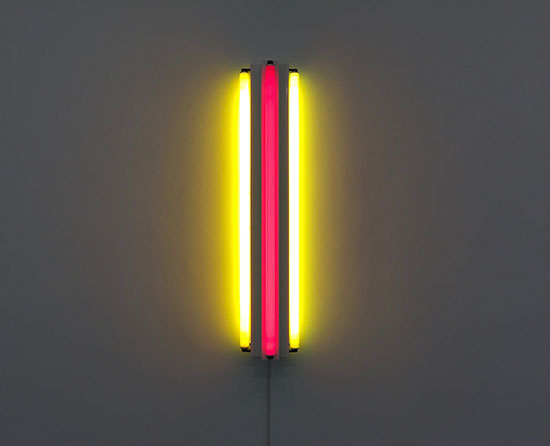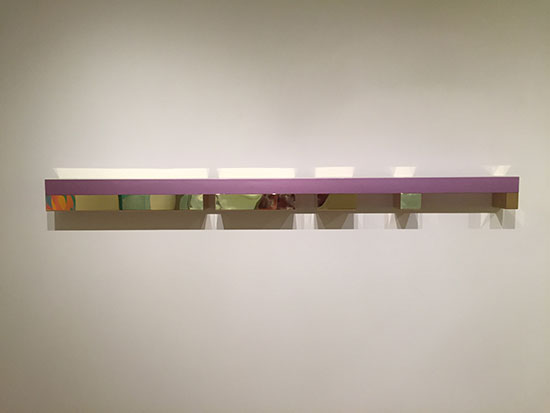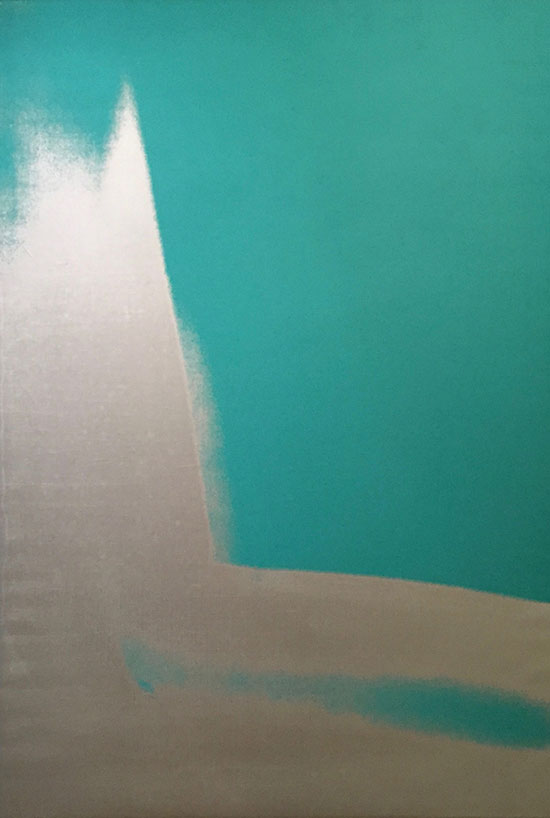When Minimalism came to the fore in the 1960s, it was seen by its adherents as a logical reaction to what were then perceived as the sensationally emotional excesses that had become the hallmark of the Abstract Expressionist artists in the postwar period.
Favoring the dispassionate and detached over the intense painterly histrionics of the Expressionists, Minimalist sculptors and painters sought to remove metaphorical symbolism from their works and replace it with a visual appeal based on a measure of aesthetic anonymity. Minimalists emphasized materials over process and favored almost complete eradication of visual information. In many ways, their works reflected the concept articulated years earlier by the author Antoine de Saint-Exupery, who stated that “perfection is achieved not when there is nothing more to add, but when there is nothing left to take away.”
This emphasis on simplicity of form and content provides a perfect through-line for experiencing “Aspects of Minimalism: Selections from East End Collections,” on view through October 10, 2016 Guild Hall Museum in East Hampton. The exhibition features works by prominent Minimalist artists as well as pieces by those who, while not necessarily considered adherents, were either an integral part of the birth of Minimalism or profoundly influenced by its aesthetic priorities.
Because the show was culled from a number of private collections, considering this exhibition a comprehensive survey of Minimalism would be off-base. A number of seminal artists of the genre are absent, such as Brice Marden, Carl Andre, or Sol Lewitt. At the same time, though, the Guild Hall exhibit nevertheless offers a broad overview of the movement and provides valuable insights into its priorities, and also illustrates its continuing impact on the direction of contemporary art and artists working today.
Of particular import in the exhibit are a number of works by Dan Flavin, whose pioneering use of configured fluorescent lights to create color through illumination can be seen as one of the most significant expansions on the limits of traditional painterly priorities in modern art.
Using light as a conceptual manifestation of the physicality of paint itself, works such as Three Fluorescent Tubes (fluorescent lights, 1963) and Alternate Diagonals of March 2, 1964 (for Don Judd) (daylight fluorescent lights, 1964) are particularly important for their connection to Russian Constructivism, a movement that influenced the Minimalists by its favoring of integrated production and industrial materials over the conventional approaches of traditional sculptural impulses.
.

"Three Fluorescent Tubes" by Dan Flavin, 1963. Fluorescent lights. Photo by Eric Ernst.
.

Dan Flavin " Alternate Diagonals of March 2, 1964 (to Don Judd)" by Dan Flavin, 1964. Daylight fluorescent lights. Courtesy of Guild Hall.
.
Another influential sculptor in the exhibition is the aforementioned Donald Judd, who consistently strove in his works to reflect the idea that art shouldn’t be tied to any form of representational interpretation. In support of this, interestingly, Judd actually objected to people calling his pieces “sculptures.”
Adhering to his own admonition to eschew any form of artistic illusion and artificially contrived space, in works like Untitled (Hernandez 94.2) (6 units of Cor-Ten steel with green Plexiglas, 1994) or Untitled (anodized aluminum and brass, 1974) that were also influenced by the Russian Constructivists, Judd highlighted the idea that structure could stand on its own absent any measure of configurational or compositional hierarchy.
.

"Untitled Hernandez 94.2" by Donald Judd. 6 Units of Cor-Ten steel with green plexiglass. Courtesy of Guild Hall.
.

"Untitled" by Donald Judd, 1974. Anodized aluminum and brass. Photo by Eric Ernst.
.
Perhaps the most surprising work in the exhibition—illustrating the impact of Minimalism even on those whose work emphasized elements well outside its superficial austerity—is Andy Warhol’s Shadow (synthetic polymer and silkscreen inks on canvas, 1978-79).
.

"Shadow" by Andy Warhol, 1978-79. Synthetic polymer and silkscreened inks on canvas. Photo by Eric Ernst.
.
Part of a series of 102 silkscreened canvas panels conceived as one painting with multiple components, in this piece there are elements that call to mind Franz Kline’s investigations into calligraphic compulsions. And the color here vibrates with an intensity that is more reminiscent of industrial influences than those emanating strictly from the human experience.
Another work of note in the exhibition is a canvas from Josef Alber’s extensive geometric studies exploring chromatic exchanges with nested squares. Titled Study for Homage to the Square: De Profundo” (oil on Masonite, 1965-68) this piece is part of the artist’s series investigating the interactions between shape and color. This series, begun in 1950, included literally hundreds of paintings and had a huge impacton on the Minimalists’ obsession with his investigations into the indistinctness of optical perception.
.

"Study for Homage to the Square: De Profundo" by Josef Albers, 1965-68. Oil on Masonite. Courtesy of Guild Hall.
.
Also of interest in the exhibition is Bridget Riley’s Java (oil on linen, 1983); Gerhardt Richter’s Wiesenfeld (oil on canvas, 1965); On Kawara’s Oct 27, 1982 (Today Series) (Liquitex on canvas, 1982); and Agnes Martin’s The Peach (oil and graphite on canvas, 1964).
.

"Java" by Bridget Riley, 1983. Oil on linen. Photo by Eric Ernst.
.
_____________________________
BASIC FACTS: “Aspects of Minimalism: Selections from East End Collections” is on view August 13 through October 10, 2016 at Guild Hall Museum, 158 Main Street, East Hampton, NY 11937. www.guildhall.org
_____________________________
Copyright 2016 Hamptons Art Hub LLC. All rights reserved.
